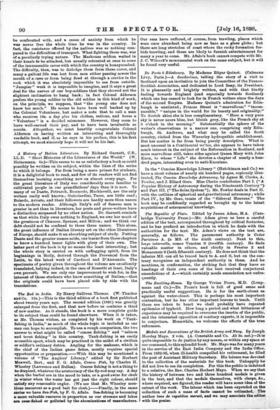De Paris a Edinbourg. By Madame Edgar Quinet. (Calmann Levy,
Paris.)—A duodecimo, telling the story of a visit to Scotland upon an invitation to join the Committee of the Franco- Scottish Association, and dedicated to Lord Reay, its President. It is pleasantly and brightly written, and with that kindly feeling towards England (and especially towards Scotland) which one has ceased to look for in French writers since the days of the second Empire. Madame Quinet's admiration for Edin- burgh is unstinted ; Princes Street is "marvellous," "incom- parable," " unique in the world for its beauty and originality." To Scotch skies she is less complimentary. "Here a very pure sky is never azure blue, but bluish grey, like the French sky at 3 o'clock in the morning." Substantially the sphere of the writer's observations is a narrow one, comprising only Edin- burgh, St. Andrews, and what may be called the Scott country, visited from the Waverley hydropathic establishment. But her matter is far from being purely descriptive. What is most unusual in a Continental wrier, she appears to have taken much interest in the subject of the Reformation in Scotland, and more marvellous still, takes sides against Queen Mary with John Knox, to whose " Life" she devotes a chapter of nearly a hun- dred pages, interesting even to anti-Knoxians.
In the " Concise Knowledge Library " (Hutchinson and Co.) we have a stout volume of nearly six hundred pages, copiously illus- trated, The Concise Knowledge Astronomy, by Agnes M. Clerke, A. Fowler, and J. Ellard Gore. Miss Clerke contributes Part I. (" A Popular History of Astronomy during the Nineteenth Century ") and Part III. (" The Solar,System"); Mr. Fowler deals in Part II. with the outlines of spherical and gravitational astronomy ; while Part IV., by Mr. Gore, treats of the " Sidereal Heavens." The book may be confidently regarded as brought up to the latest acquisitions of astronomical knowledge.


































 Previous page
Previous page